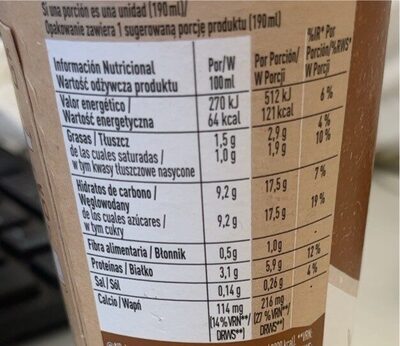Shakissimo Latte Espresso - Nescafé - 190 ml
Aquesta pàgina del producte no està completa. Podeu ajudar a completar-la editant-la i afegint-hi més dades a partir de les fotos ja disponibles, o fent-ne més amb l'aplicació de androide o iPhone / iPad. Gràcies!
×
Codi de barres: 8594002786403 (EAN / EAN-13)
Quantitat: 190 ml
Empaquetament: Plàstic, en:Pot
Marques: Nescafé
Categories: Aliments i begudes amb base vegetal, Begudes, Productes làctics, Aliments amb base vegetal, Begudes làcties, Cafè, Begudes instantànies, Begudes sense alcohol, Begudes sense sucre, Cafès solubles
Etiquetes, certificacions, premis: es:Cultivado con respeto
Llocs de fabricació o processament: Llobregat Barcelona España
Codi de traçabilitat: FR 14.630.010 CE - Saint-Martin-des-Entrées (Calvados, France)
Enllaç a la pàgina del producte en el lloc oficial del productor: http://www.nestle.es
Matching with your preferences
Entorn
Petjada de carboni
Empaquetament
Transport
Report a problem
Fonts de dades
Producte afegit per kiliweb
Última modificació de la pàgina del producte per kiliweb.
La pàgina del producte, també editada per acuario, openfoodfacts-contributors, packbot, quechoisir, trinukso, vaporous, yuka.UTVvYUlvbFovdnNJdWNBMDdFdlp3dGhTOXM2emJFbVBkK1V0SVE9PQ, yuka.V2FFUFRQVUQvT1lNa2ZFMTVETGVwK3hRMmFHVVludW9Cc3cvSUE9PQ, yuka.WGY4TlBiZ3JwdndibWZGaDB6U0Y2dE5IekpHSlVWaVFDTkFESVE9PQ, yuka.sY2b0xO6T85zoF3NwEKvlh1FadfCvRSVFyDkiXaK74qAdLi5YspxxKLjHKs, yuka.sY2b0xO6T85zoF3NwEKvln1ZSv3EgmroCkDkh3O75IaRKqXZYspw3JDzNKg.








